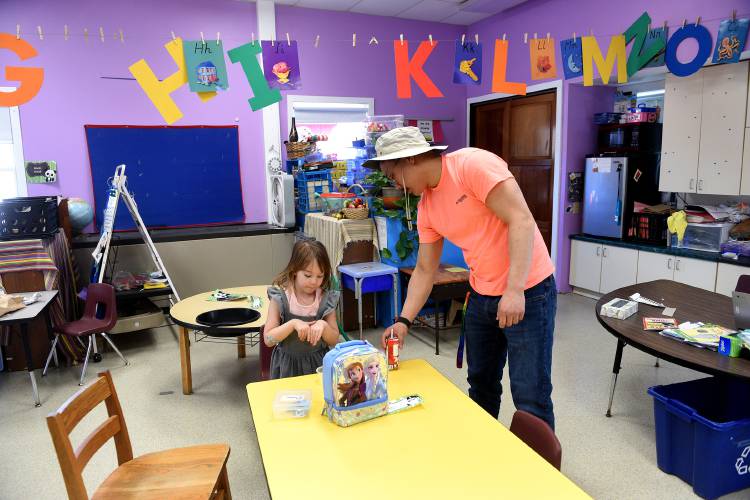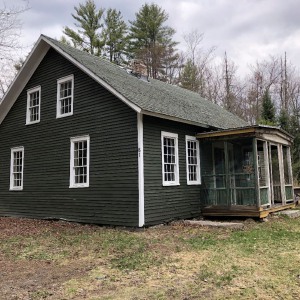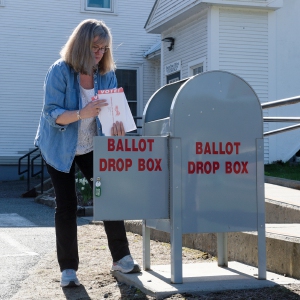Cornish, Plainfield mull deeper collaboration on schools to reduce costs

Cornish Elementary School Pre-K teacher Lee Cogan helps student Eliana Parker, 4, get ready for recess at the school in Cornish, N.H. on Monday, April 4, 2022. Students and staff at the school can no longer drink the school's well water due to PFOA contamination.(Valley News - Jennifer Hauck) Copyright Valley News. May not be reprinted or used online without permission. Send requests to permission@vnews.com. Jennifer Hauck
| Published: 12-04-2023 4:33 PM |
PLAINFIELD — As they face staffing shortages and high costs, the Plainfield and Cornish school boards are considering several potential models for restructuring the relationship between two school administrative units, SAUs.
Under the current structure, Plainfield and Cornish each have an elementary and middle school with a five-member board.
The two districts are able to create some efficiencies such as sharing certain staff members, including a superintendent, a business administrator, special education teacher and several other positions.
“We keep cooperating more and more,” Jason Tetu, a Cornish School Board member, said during a joint meeting of the boards on Nov. 27. “But there’s only so far you can go” with the current structure.
The hope is that the two districts, which currently cooperate in many ways, may be able to formalize an administrative relationship that solves some of their larger challenges, such as staffing shortages, transportation and rising expenses.
Cornish Elementary School currently serves 135 students in grades pre-K through 8th grade, with school choice allowing for tuition agreements with high schools in Windsor, Hartford and Claremont. Plainfield’s kindergarten through 8th grade school serves 199 students and has a tuition agreement with Lebanon High School.
One restructuring possibility would be to have a combined middle school, with each district maintaining its own elementary schools. Alternatively, the two districts could have one shared elementary school and one shared middle school, or simply a single, shared pre-K-8 school.
It would also be theoretically possible for one or both districts to close their schools and create tuition agreements with neighboring districts.
Article continues after...
Yesterday's Most Read Articles
 Dartmouth administration faces fierce criticism over protest arrests
Dartmouth administration faces fierce criticism over protest arrests
 Hanover house added to New Hampshire Register of Historic Places
Hanover house added to New Hampshire Register of Historic Places
 Sharon voters turn back proposal to renovate school
Sharon voters turn back proposal to renovate school
Goshen, N.H., for example, does not maintain a school and has K-12 tuition agreements, but Sydney Leggett, superintendent for both the Cornish and Plainfield school districts, made it clear that this option was included simply for the sake of thoroughness.
Leggett emphasized that no binding decisions would be made at the Nov. 27 meeting.
She stressed that it was a “20,000-foot view of the wide variety of relationships that Plainfield and Cornish could have with their districts at this point.”
Some of the challenges that district restructuring might address are staffing shortages, the difficulty in finding employees willing to work part time, transportation costs, and inefficient purchasing power for larger expenditures such as curricular software. The staffing shortages in particular have created heavy workloads and what Leggett called the “burnout potential of the status quo.”
“We share similar challenges,” said Melissa Drye, another Cornish School Board member, who noted that the question before them was whether to “address those challenges separately or together.”
The models became slightly more complex at the SAU level, where the number and size of boards, degree of local control, administrative burdens, and weighted voting were all considerations. Weighted voting at the SAU board level would be determined according to equalized property valuation and Average Daily Membership (ADM), which is the number of students in a given district receiving an education at the public expense.
As the board members considered the pros and cons of each potential model, it became clear that the determining factor would be the overall cost savings.
As Leggett put it: “The only way to save money is through some sort of cooperative agreement,” which would create the ability to streamline big expenses such as payroll and technology.
In addition, a cooperative district model would allow the sharing of all staff including substitutes, which would cut costs significantly in the largest budget line item, which is personnel.
However, Leggett noted that with cooperative agreements there is the perception of less local control.
“To a certain extent that’s true, because it’s not just you anymore,” she said.
Using personal relationships as an analogy, she said that along the spectrum of dating, living together and marriage, “the cooperative is really the marriage.”
This is because the cooperative model would involve the creation of a single SAU for both elementary schools with separate high school districts.
Should the boards decide to pursue one of the possible structural options, a warrant article would be put forward to create a planning committee to carry out a formal study.
Even then, Leggett noted, “that doesn’t mean that you’re deciding on the SAU structure.”
The study would likely extend over the course of a year or more before being brought to the public. But, she said, “the conversation should start about what direction the boards are interested in pursuing.”
The next step in the process is for each board to discuss the issue at its December meeting.
The Plainfield School Board will meet on Dec. 12 at 5:30 p.m. at the Plainfield Elementary School.
The Cornish School Board’s next regular meeting is scheduled for Dec. 18 at 5:30 p.m. at the Cornish Elementary School.
Christina Dolan can be reached at cdolan18020@gmail.com.

 Students take down pro-Palestinian encampment at UVM
Students take down pro-Palestinian encampment at UVM
